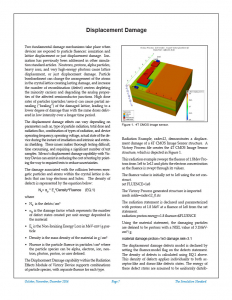Displacement Damage
Two fundamental damage mechanisms take place when devices are exposed to particle fluences: ionization and lattice displacement or just displacement damage. Ionization has previously been addressed in other simulation standard articles. Neutrons, protons, alpha particles, heavy ions, and very high-energy photons cause lattice displacement, or just displacement damage. Particle bombardment can change the arrangement of the atoms in the crystal lattice creating lasting damage, and increase the number of recombination (defect) centers depleting the minority carriers and degrading the analog properties of the affected semiconductor junctions. High dose rates of particles (particles/area-s) can cause partial annealing (“healing”) of the damaged lattice, leading to a lower degree of damage than with the same doses delivered in low intensity over a longer time period.
The displacement damage effects can vary depending on parameters such as, type of particle radiation, total dose and radiation flux, combination of types of radiation, and device operating frequency, operating voltage, actual state of the device during the instant of irradiation and intrinsic and extrinsic shielding. These issues makes thorough testing difficult, time consuming, and requiring a significant number of test samples. Silvaco’s displacement damage capability with Victory Device can assist in reducing the cost of testing by pointing the way to required tests to reduce uncertainties.
The damage associated with the collision between energetic particles and atoms within the crystal lattice is defects that can trap electrons and holes. The density of defects is represented by the equation below:



